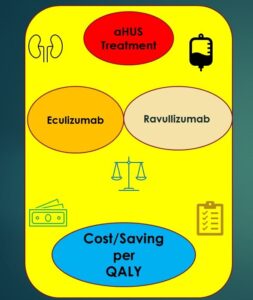Article No 394
23 November 2020

In an article on 16 October 2020 (No 388) aHUS Global Action derived a cost effectiveness figure for Ravulizumab for the treatment of aHUS using the Incremental cost per QALY method. It was done by extrapolating figures from a publication about the cost effectiveness of ravulizumab for treating PNH. The result was a saving of $5.8m per QALY.
Recently Alexion has published an article specific to aHUS cost reduction, but using a different economic model method i.e. a cost-minimisation model (CMM) . (The full article can be read here). This method just focuses on the costs and ignores any comparative quality improvement to patients’ lives, so assuming them to be the same for both ravulizumab and eculizumab treatment. The drug prices used were USA wholesale/medicare/medicaid listed prices.
CMM figures were calculated for adults and children (see below) and are based on the life time horizon ( up to 100 years) costs for each drug. The key development is that Alexion acknowledge that some patients may discontinue treatment; though some may relapse and return to treatment. Its views on the possibility of withdrawal therefore remain very conservative (they assume only 45% of those with chronic kidney disease levels 0 to 3 ,who represent about 11% of all aHUS patients treated with these “lizumabs” ,would be able to discontinue treatment.
Table : Comparative life time horizon costs of treatment
| Discounted* | Discounted* | Un-discounted | Undiscounted | |||
| $million | Ravulizumab | Eculizumab | Diff. | Ravulizumab | Eculizumab | Diff. |
| Adult | 12.1 | 17.9 | -5.8 | 25.2 | 37.4 | -12.2 |
| Children | 11.6 | 18.0 | -6.4 | 36.5 | 55.3 | -18.9 |
*discount rate 3%
A life time cost of treating an aHUS child with eculizumab would be just over $55m at list prices and prescribed weight steps and dosing intervals. Treating the same child with ravulizumab would save just under $19m. However “discounting” the figures, as health economists do , at 3% per year brings the saving down to $6.4m at today’s prices.
Alexion believe that an overall saving from ravulizumab could be $5.8m for adults. Alexion’s and Global Action’s figures being the same is just coincidental.
One is the cost saving per QALY based on a lifetime cost saving of $4.2m and a QALY gain of 0.72. The other is an overall life time CMM. Alexion’s figure, if turned into a saving per QALY, would be about -$8.1m per QALY. So better still.
Roughly a monetary saving of a third of the cost of eculizumab.
Further evidence that ravulizumab is more cost effective for treating aHUS than eculizumab over a patient’s life time of use.
In its conservative estimate of the number of patients being able to discontinue treatment Alexion reveal that 89% of aHUS patients are left with CKD levels 4 and 5, despite treatment with eculizumab. The residual impact on kidneys function however does relate to the timeliness of the patient’s diagnosis.
If diagnosis could be sooner and treatment begun earlier there could be better residual renal function outcomes. Better renal function outcomes could mean that more patients could discontinue treatment in time. Making treatment even more cost effective.
But which ever way it is looked at Ravulizumab is going to be more affordable/cost effective/cheaper than eculizumab.
And yet can be even more so.

